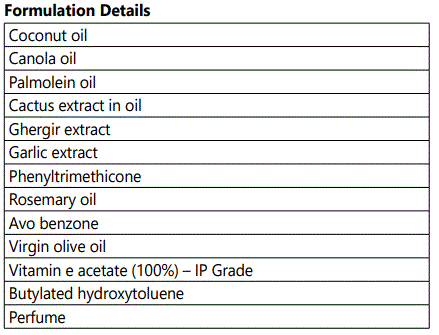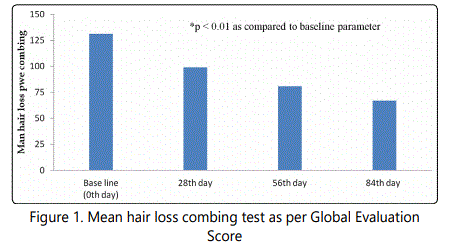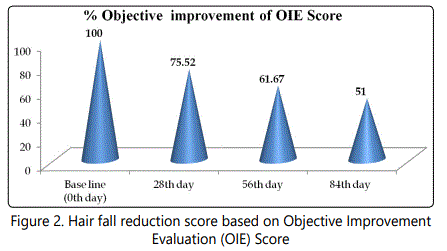Research Article
Clinical Evaluation of Cactus (Cereus Grandiflorus) Enriched Hair Oil for Hair Fall Disorders
1Dabur Research & Development, International Business Division, Dubai, P.O.Box. 6399, United Arab Emirates
2Sarkone Lifesciences-Dubai, United Arab Emirates
*Corresponding author: Sudhir Sawarkar, Dabur Research & Development, International Business Division, Dubai, P.O.Box. 6399, United Arab Emirates, E-mail: sudhir.sawarkar@mail.dabur
Received: June 23, 2018 Accepted: July 13, 2018 Published: July 18, 2018
Citation: Sawarkar S, Deshmukh V, Jayaganesh S, Perumal O. Clinical Evaluation of Cactus (Cereus Grandiflorus) Enriched Hair Oil for Hair Fall Disorders. Madridge J Dermatol Res. 2018; 3(1): 61-64. doi: 10.18689/mjdr-1000113
Copyright: © 2018 The Author(s). This work is licensed under a Creative Commons Attribution 4.0 International License, which permits unrestricted use, distribution, and reproduction in any medium, provided the original work is properly cited.
Abstract
Hair fall provokes anxiety and distress, which reflects the symbolic and psychosocial importance of hair. Main reasons for hair loss are anagen phase, poor blood flow, sebum, emotional stresses, nerves disorders, aging, hair hygienic care pattern, infections, hormonal imbalance, pollution, radiation etc. Cereus grandiflorus (cactus) Flower extract very much pronounced with respect to hair fall control. It contains the higher amount of betacyanins and flavonolglycosides. Present study aimed to generate the authentic documents about the safety and efficacy of Cactus enriched hair oil performance on patients suffering from the hair fall disorders. Sixty alopecia patients were enrolled for the study with average age of 35.7 ± 10.8 years. Patients of either sex in the age group varied between 18 and 65 years. Overall clinical study results revealed that usage of herbal hair oil containing Cereus grandiflorus (cactus) Flower extract is effective and significantly reduce the hair fall. Efficacy was analyzed with changes in the intensity of hair fall over 12 weeks from baseline to treatment visits using Objective Improvement Evaluation Score and subjects response to Global Evaluation Score. None of the subjects had distressing hair fall at the time of enrolment. Cactus containing the higher amount of anti-oxidant potential and it helps the healthy sebum in the scalp and aromatherapy also plays a vital role in alopecia treatment. The gentle massage reduce the stress and increase the blood circulation, in addition to that many scientist proved that cactus oil helps to increase the blood circulation; higher blood circulation minimize the alopecia. Application /usage of herbal hair oil containing the Cereus grandiflorus (cactus) Flower extract is a safe and effective in terms of hair loss prevention. It helps for regenerate the new hair growth by continuous application of 12 weeks.
Keywords: Cactus Hair Oil; Cereus Grandiflorus; Hair Oil; Alopecia Treatment; Hair Fall Control.
Introduction
Hair is one of the vital parts of the body derived from ectoderm of the skin and it is ornament structure with sebaceous gland [1-4]. Hair follicles are regenerating it. Hair growth divided into the three stages namely; anagen phase (growth phase); catagen phase (involution) and telogen (rest) phase. Color fading, dandruff, roughness of the hair, falling of hair, split end of the hair are associated problems of hair. Hair fall is a common disorder and it affects men and women of all ages, and about 50% of men and women suffer from hair loss by the age of 40. Loss of hair is not life threatening, but has philosophical impact on social impact [2]. Hair fall provokes anxiety and distress, which reflects the symbolic and psychosocial importance of hair. Main reasons for hair loss are anagen phase, poor blood flow, sebum, emotional stresses, nerves disorders, aging, hair hygienic care pattern, infections, hormonal imbalance, pollution, radiation etc. Hair loses divided into the four major categories [5]. Androgenetic or androgenic alopecia (baldness) is the most common hair loss noticed across the men and it also called as hereditary baldness. In this category hair follicle size is reduced and growth phase diminished. Androgenetic alopecia and diffuse hair loss (telogen effluvium) are the common causes, while alopecia areata (patchy balding) affects 1.7% of the population. Alopecia areata is lost the hair from the scalp or from the whole body [5-6]. Telogen effluvium is characterized by the early entrance of a large no of hairs into telogen phase at one time. Some time the hair loss also occurred due to the treatment of cancer time i.e. chemotherapy treatment. Telogen effluvium is the name for the temporary hair loss due to the shedding of resting or telogen hair after some shock to the system and then the new hair grows continued. It is distinguished from the anagen effluvium, in which the hair shedding is due to interruption of active or anagen hair growth by drugs, toxins or inflammation. Telogen effluvium develops over a period of several months, is usually, not a permanent form of hair loss, and eventually, the hair follicles can recover. The potential causes of telogen effluvium include malnutrition and crash dieting, pregnancy and childbirth, UV radiation exposure, drugs, endocrine disorders, extreme physical and emotional stress, and severe systemic illness. Topical application of biological response modifiers and antiandrogens are currently available therapies for the management of telogen effluvium; however, the low success rate and associated adverse effects limit their clinical use. Many researchers proved that various herbal materials helped to prevent the hair fall disorders [7-10]. Among the various materials Cereus grandiflorus (cactus) Flower extract very much pronounced with respect to hair fall control. It is a green stemmed climber herb, indigenously found in Jamica and West Indies. It contains the higher amount of betacyanins and flavonolglycosides. Flavonolglycosides consist of 1.5% narcissi (Lycorine 0.05%), cacticin (0.02%), rutoside (rutin or quercetin-3-rutinoside), hyperoside (quercetin-3-β-D-galactopyranoside), kaempferitrin (kaempferol-3, 7-O-dirhamnoside) and grandiflorine. Various biogenic amines like tyramine (0.3%), N-methyl tyramine and N, N-dimethyltyramine (Hordenine) etc., mucus, fat and waxes have also presented in the stems [10].
Here, we investigated the effectiveness of a topical application of Herbal hair oil for primary hair fall disorders, preventing hair loss. Many researchers reported that the Cereus grandiflorus (cactus) Flower extract as a useful remedy for the treatment for hair loss problems. So we have aimed to generate the authentic documents about the safety and efficacy of Cactus enriched hair oil performance on patients suffering from the hair fall disorders.
Materials and Methods
Main objective of the study was to estimate the clinical efficacy and safety assessment of Cactus Hair oil in the management of alopecia aerate.
Sample Preparation
Below mentioned raw material add one by add and stir for 5 minutes for each raw material addition. Finally add the perfume sample and blend for 15 minutes. Prepared hair oils fortified with Cereus grandiflorus (cactus) Flower extract, Olea europaea (olive) fruit oil, Euruca sativa Seed extract, Allium sativum (garlic) bulb extract, Tocopheryl (Vitamin E) acetate, Rosmarinus officinalis (Rosemary) Leaf oil along with base ingredients is known to be effective in providing long lasting and effective relief in hair loss with practically no side effects.

Clinical Study
Study was an open clinical trial, conducted by STANDEV Research Private Limited, Mumbai, India. The study protocol, case report forms, product information and informed consent forms were approved by the local ethical committee.
Sixty alopecia patients were enrolled for the study with average age of 35.7 ± 10.8 years. Patients of either sex in the age group varied between 18 and 65 years. Patients are selected based on the suffering of various alopecia and hair fall issues. Study was multicenter, open, single arm and proof of concepts clinical study with no control groups method. Efficacy was estimated with changes in the intensity of hair fall over 12 weeks from the baseline to treatment visits using Global Evaluation Score and Objective Improvement Score. All the patients were advised to apply about the 5 mL of the tested product locally applied on the scalp and hair every day for a period of 12 weeks. Also advised gentle massage on the scalp, leave on the oil during overnight period without using the hot/heat blow drying. Subjects were given a weekly questionnaire to determine qualitatively the status of their hair fall as well as the presence of side effects.
Primary and Secondary End Points
The predefined primary efficacy end points were improvements in the subjective and objective score, the subjective evaluation was done using the Global Evaluation Score i.e. 0 = Poor, 1 = Fair; 2 = Good & 3 = Excellent). The objective improvement evaluation included; i.e. 1. Mean number of hair lost during one minute combing test > 150 hairs lost = Poor; 100 - 150 hairs lost = Fair and 50 – 100 hairs lost = Good. The secondary end point was adverse effects reported by the patients/subjects. Subject / patients selection exclusion criteria summarized as below;
Exclusion Criteria
Statistical Analysis
Treated group results were compared with the control group. The results were analyzed statistically using Student's t-test to identify the differences between the treated and control. Base line value compared with various analyzed interval using the ‘Repeated Measures ANOVA Test'. The minimum level of significance was fixed at 99% confidence limit and a 2-sided p value of <0.05 was considered as significant.
Results
Overall clinical study results revealed that usage of herbal hair oil containing Cereus grandiflorus (cactus) Flower extract is effective and significantly reduce the hair fall. Efficacy was analyzed with changes in the intensity of hair fall over 12 weeks from baseline to treatment visits using Objective Improvement Evaluation Score and subjects response to Global Evaluation Score. None of the subjects had distressing hair fall at the time of enrolment. The average response of Global Evaluation Score for visit1 and visit 4 was 0.950 and 2.367 respectively. The 95% confidence interval for the difference of Global Evaluation Score between the visit1 and visit 4 was (-1.5901, -1.2433) and the corresponding p-value was <.0001which is less than the alpha level 0.05. The average response of Objective Improvement Evaluation score for Visit1 is 131.20 and Visit 2 having the score of 99.083 and Visit 3 having the 80.92 and Visit 4 was having the score of 66.197 and the detailed mean hair loss combing summarized in Figure 1.
The 95% confidence interval for the mean difference of Objective improvement Evaluation score between the visit1 and visit2, visit3 and visit4 are presented in Figure 2. According to the Objective Improvement Evaluation score, the mean number of hair lost during one minute combing test transfer from fair to good category due to the application of tested products. In figure 2 clearly revealed that there is a statistically sifnificant difference in the average response of Global Evaluation Score (GES) and Objective improvement evaluation during the study period. Significant reduction is observed in the intensity of hair loss of all enrolled patients/subjects. The values of efficacy of GES and OIE show a statistically significant difference between the average responses, percent improvement over a period of 12 weeks study period.
Patients/subjects were asked to evaluate the presence of adverse effects of the herbal hair oil treatment. There were no clinically significant adverse reactions, either reported or observed, during the entire study period and overall compliance to the treatment was excellent.


Discussion
Alopecia is a highly non predictable and common disease; many synthetic drugs are available in over the counter itself. Minoxidil is a best example for hair growth synthetic drug and it has scientifically proved for the treatment of aloepecia [11]. However, the continuous usage of synthetic drugs caused the many adverse side effects. So consumers are moved out from the synthetic drugs and adopt the herbal aid treatment. Herbal oils treatments of alopecia provide the following benefits like, nutritional support, 5-α-reductase blockers, and improved scalp blood circulation. Many researchers proved that flavonoids helps to hair growth and also prevent the hair loss. Cactus containing the higher amount of flavonoids and it helps to prevent the hair loss and reuce the 5- -α-reductase. [10, 12, 13]. Similarly the cactus containing the higher amount of anti-oxidant potential and it helps the healthy sebum in the scalp. Many scientist also proved that the aromatherapy also play a vital role in alopecia treatment [14-15]. Because the gentle massage reduce the stress and increase the blood circulation, in addition to that many scientists proved that cactus oil helps to increase the blood circulation higher blood circulation minimize the alopecia [16].
Conclusion
Application /usage of herbal hair oil containing the Cereus grandiflorus (cactus) Flower extract is a safe and effective in terms of hair loss prevention. It helps for regenerate the new hair growth by continuous application of 12 weeks.
Acknowledgement
The researchers thank Mr. Kirshna Kumar Chutani, CEO and Mr. Jude Linhares - Head of operation for their constant encouragement and support for the study.
Conflict of Interest
The authors declare no conflicts of interest.
References